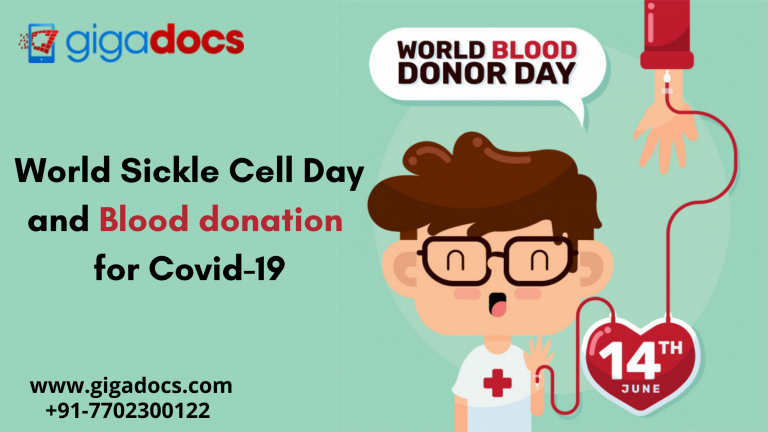Safe blood transfusion is a critical element of patient care and it saves hundreds of lives every day while also enhancing the health and well-being of a large number of individuals. The accessibility to blood for those who need it has become very difficult. In developing countries, blood shortages are particularly severe.
Blood donor day and Covid-19
Despite the pandemic, blood and plasma donors have continued to donate to patients requiring transfusions. This has highlighted the critical role of dedicated blood donors in assuring a safe and sufficient blood supply in both normal conditions and in emergencies.
Blood donation is critical to the health of the community. With the dwindling numbers of Covid-19 cases, hospitals have begun to resume non-covid surgical procedures, increasing the requirement of blood donations for patient treatment.
World Blood Donor Day
14th June is observed as World Donor Day across the world. The goal is to raise global awareness about the necessity of safe blood for transfusions. The day is an occasion to urge governments and national health authorities to allocate necessary resources and implement procedures and infrastructures to enhance blood collection from volunteers.
To donate blood post the pandemic, blood donors must meet the following criteria-
- If you do not have a fever, you can donate after you’ve been clear of symptoms for at least 24 hours.
- You must wait for at least 14 days after being diagnosed with COVID-19 before donating blood. A severe infection that requires hospitalization is subject to a three-month delay period.
- Close contact with someone who has tested positive for coronavirus calls for a 14 or 21-day deferral period.
Sickle Cell Anemia and Blood Donation
Severe anemia necessitates the requirement for urgent blood donation, whereas Sickle Cell disease impairs the quality of red blood cells making blood donation difficult. Sickle Cell Anemia passes from one generation to another, it cannot be acquired.
In normal cases, the flexible, spherical red blood cells flow freely across blood channels. In sickle cell anemia, the red blood cells look like crescent moons or sickles which can clog small blood vessels, preventing blood and oxygen from reaching other parts of the body.
World Sickle Cell Day
June 19 is World Sickle Cell Day, an UN-designated day to encourage sickle cell awareness nationally and internationally. The United Nations passed a resolution on the 22nd of December, observing Sickle Cell as one of the world’s leading hereditary diseases.
Symptoms of sickle cell anemia usually begin around the age of five months. They differ from one individual to the next and evolve with time. Here are the signs and symptoms of sickle cell anemia-
The following are examples of signs and symptoms:
- Anemia- Sickle cells readily disintegrate and die, leaving the patient with an insufficient number of red blood cells. In normal cases, red blood cells last approximately 120 days before having to be replaced. Sickle cells, on the other hand, normally die in 10 to 20 days, resulting in a deficiency of red blood cells and anemia.
- Painful Episodes- Pain crises are symptomatic of sickle cell anemia, which develops when sickle-shaped red blood cells restrict blood flow to the chest, belly, and joints through tiny blood vessels. In addition, chronic pain can affect teenagers and adults because of their bone and joint deterioration, ulcers, and other conditions.
- Hands and Feet Swelling- The sickle-shaped red blood cells limit blood flow to the hands and feet, causing edema.
- Frequent Infection- Sickle cells damage an infected person’s spleen, making them more susceptible to infections. Vaccinations and antibiotics are regularly given to newborns and children with sickle cell anemia to prevent potentially life-threatening illnesses like pneumonia.
- Vision Issues- Sickle cells can clog the tiny blood arteries of the eyes which can cause impaired vision by damaging the retina.
Stroke, acute chest syndrome, blindness, and bone loss are all risks that are associated with sickle cell disease, which can harm organs such as the heart, kidney, lungs, liver, and spleen. Complications might also lead to death.
Complications of Sickle Cell Anemia
Sickle cell anemia can cause several complications like-
- Stroke- Blood flow stops to a portion of the brain, blocked by sickle cells resulting in a stroke whose symptoms include seizures, numbness or paralysis in your arms and legs, abrupt speech difficulties, and loss of consciousness.
- Acute chest syndrome- Acute chest syndrome is a life-threatening condition caused by a lung infection or sickle cells clogging the blood arteries in the lungs, causing chest discomfort, fever, and difficulty breathing. It may demand immediate medical attention.
- Pulmonary Hypertension- High blood pressure in the lungs can occur in people with sickle cell anemia. Adults are most commonly affected by this condition. Shortness of breath and exhaustion are prominent indications of this potentially lethal illness.
- Organ damage- Sickle cells obstruct blood flow to organs, starving them of oxygen and blood. Sickle cell anemia causes persistent oxygen deficiency in the blood. This lack of oxygen-rich blood can cause damage to nerves and organs like the kidneys, liver, and spleen, which can even lead to death.
- Blindness- Sickle cells can obstruct the tiny blood arteries that supply oxygen and nutrients, which can harm the eyes and lead to blindness over time.
- Ulcers on the legs – Open sores on the legs are a symptom of sickle cell anemia.
- Gallstones- They are caused by a high quantity of bilirubin in the body, a chemical produced by the breakdown of red blood cells.
- Pregnancy complications- Sickle cell anemia can increase the risk of high blood pressure and blood clots during pregnancy. It also raises the risk of miscarriage, premature birth, and low birth weight in newborn babies.
When to see a doctor
Sickle cell disease is a chronic sickness that lasts a lifetime. A blood and bone marrow transplant is currently the most adopted cure for sickle cell disease.
Severe discomfort in the belly, chest, bones, or joints, one-sided paralysis or weakness in the face, arms, or legs; confusion; difficulty walking or talking; sudden visual changes or inexplicable numbness; or an intense headache should not be ignored. Discuss your symptoms on the Gigadocs app if you experience any fatigue, pale yellowish nails, or eyes.
Unattended Anemia can be dangerous and is very common in our country. Gigadocs is your partner in wellness and good health. Now you can earn points booking a telehealth care specialist or while availing any Medicare services on the Gigadocs app, and redeem it for discounts while consulting doctors on the Gigadocs app.
Download Gigadocs app-
IOS App – apple.co/2W2iG4V
Android App – bit.ly/33AQoRC
To know more email info@gigadocs.com




